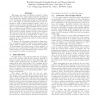Free Online Productivity Tools
i2Speak
i2Symbol
i2OCR
iTex2Img
iWeb2Print
iWeb2Shot
i2Type
iPdf2Split
iPdf2Merge
i2Bopomofo
i2Arabic
i2Style
i2Image
i2PDF
iLatex2Rtf
Sci2ools
CVPR
2000
IEEE
2000
IEEE
Spatio-Temporal Analysis of Omni Image
This paper describes an efficient method to obtain 3D information by using spatio-temporal analysis of omni images for outdoor navigation and map-making in the intelligent transportation system (ITS) application. Two types of omni-directional cameras are employed to make a spatio-temporal volume, which is a sequence of omni images stacked in the spatio-temporal space. For the spatio-temporal analysis of an omni image, we define several different cross sections in such spatio-temporal volumes, and examine characteristics of the traces of image features on the cross sections. We determine that the vertical straight lines in the real world are preserved as straight lines on these cross sections and that the degree of this slope represents the quotient of the velocity of the camera motion and the depth of the object. To acquire 3D information using these characteristics, we propose a hybrid method of the epipolar-plane image (EPI) analysis and the models-based analysis. To demonstrate the...
Computer Vision | Cross Sections | CVPR 2000 | Omni-directional Video Camera | Spatio-temporal Analysis | Spatio-temporal Space | Spatio-temporal Volumes |
| Added | 12 Oct 2009 |
| Updated | 12 Oct 2009 |
| Type | Conference |
| Year | 2000 |
| Where | CVPR |
| Authors | Hiroshi Kawasaki, Katsushi Ikeuchi, Masao Sakauchi |
Comments (0)

